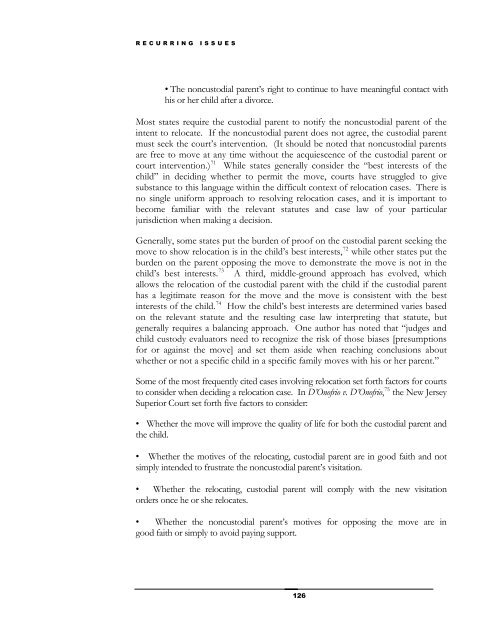A Judge’s Guide
A Judge’s Guide
A Judge’s Guide
You also want an ePaper? Increase the reach of your titles
YUMPU automatically turns print PDFs into web optimized ePapers that Google loves.
RECURRING ISSUES<br />
• The noncustodial parent’s right to continue to have meaningful contact with<br />
his or her child after a divorce.<br />
Most states require the custodial parent to notify the noncustodial parent of the<br />
intent to relocate. If the noncustodial parent does not agree, the custodial parent<br />
must seek the court’s intervention. (It should be noted that noncustodial parents<br />
are free to move at any time without the acquiescence of the custodial parent or<br />
court intervention.) 71 While states generally consider the “best interests of the<br />
child” in deciding whether to permit the move, courts have struggled to give<br />
substance to this language within the difficult context of relocation cases. There is<br />
no single uniform approach to resolving relocation cases, and it is important to<br />
become familiar with the relevant statutes and case law of your particular<br />
jurisdiction when making a decision.<br />
Generally, some states put the burden of proof on the custodial parent seeking the<br />
move to show relocation is in the child’s best interests, 72 while other states put the<br />
burden on the parent opposing the move to demonstrate the move is not in the<br />
child’s best interests. 73 A third, middle-ground approach has evolved, which<br />
allows the relocation of the custodial parent with the child if the custodial parent<br />
has a legitimate reason for the move and the move is consistent with the best<br />
interests of the child. 74 How the child’s best interests are determined varies based<br />
on the relevant statute and the resulting case law interpreting that statute, but<br />
generally requires a balancing approach. One author has noted that “judges and<br />
child custody evaluators need to recognize the risk of those biases [presumptions<br />
for or against the move] and set them aside when reaching conclusions about<br />
whether or not a specific child in a specific family moves with his or her parent.”<br />
Some of the most frequently cited cases involving relocation set forth factors for courts<br />
to consider when deciding a relocation case. In D’Onofrio v. D’Onofrio, 75 the New Jersey<br />
Superior Court set forth five factors to consider:<br />
• Whether the move will improve the quality of life for both the custodial parent and<br />
the child.<br />
• Whether the motives of the relocating, custodial parent are in good faith and not<br />
simply intended to frustrate the noncustodial parent’s visitation.<br />
• Whether the relocating, custodial parent will comply with the new visitation<br />
orders once he or she relocates.<br />
• Whether the noncustodial parent’s motives for opposing the move are in<br />
good faith or simply to avoid paying support.<br />
126 126


